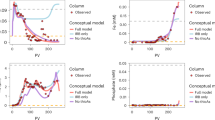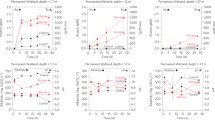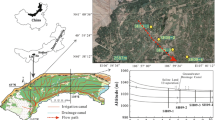Abstract
Concentrations of dissolved arsenic in ground-water in alluvial basins of Arizona commonly exceed 50 μg L−1 and reach values as large as 1,300 μg L−1. Arsenic speciation analyses show that arsenic occurs in the fully oxidized state of plus 5 (As+5), most likely in the form of HAsO4∼2, under existing oxidizing and pH conditions. Arsenic in source areas presumably is oxidized to soluble As before transport into the basin or, if after transport, before burial. Probable sources of arsenic are the sulphide and arsenide deposits in the mineralized areas of the mountains surrounding the basins. Arsenic content of alluvial material ranged from 2 to 88 ppm. Occurrence and removal of arsenic in ground-water are related to the pH and the redox condition of the ground-water, the oxidation state of arsenic, and sorption or exchange. Within basins, dissolved arsenic correlates (P<0.01) with dissolved molybdenum, selenium, vanadium, and fluoride and with pH, suggesting sorption of negative ions. The sorption hypothesis is further supported by enrichment of teachable arsenic in the basin-fill sediments by about tenfold relative to the crustal abundance and by as much as a thousandfold relative to concentrations found in ground-water. Silicate hydrolysis reactions, as defined within the alluvial basins, under closed conditions cause increases in pH basinward and would promote desorption. Within the region, large concentrations of arsenic are commonly associated with the central parts of basins whose chemistries evolve under closed conditions. Arsenic does not correlate with dissolved iron (r = 0.09) but may be partly controlled by iron in the solid phase. High solid-phase arsenic contents were found in red clay beds. Large concentrations of arsenic also were found in water associated with red clay beds. Basins that contain the larger concentrations are bounded primarily by basalt and andesite, suggesting that the iron content as well as the arsenic content of the basin fill may play a role in the occurrence of arsenic in ground-water. Under oxidizing conditions in Arizona, arsenic in ground-water appears to be controlled in part by sorption or desorption of HAsO4∼2 on active ferric oxyhydroxide surfaces.
Similar content being viewed by others
References
Anderson, T.W. 1980. Study plan for the regional aquifer-system analysis of alluvial basins in south-central Arizona and adjacent States. US Geological Survey Open-File Report 80-1197, 22pp.
Ball, J.W., Jenne, E.A. and Nordstrom, D.K. 1979. WATEQ2: A computerized chemical model for trace and major element speciation and natural equilibria of natural water. In: Jenne, E.A. (ed.).Chemical Modeling in Aqueous Systems Speciation Sorption, Solubility, and Kenetics. American Chemical Society Symposium Series 93, pp.815–836. Washington, DC.
Ball, J.W., Nordstrom, D.K. and Jenne, E.A. 1980. Additional and revised thermochemical data and computer code for WATEQ2 A computerized chemical model for trace and major element speciation and mineral equilibria of natural waters. US Geological Survey Water-Resources Investigations 78-116, 109pp.
Fenneman, N.M. 1931.Physiography of the Western United States, p. 534. McGraw-Hill, New York.
Gulens, J., Champ, D.R. and Jackson, R.E. 1979. Influence of redox environments on the mobility of arsenic in ground water.American Chemical Society Symposium, Series 93, pp.81–93.
Hem, J.D. 1985. Study and interpretation of the chemical characteristics of natural water, 3rd edn. US Geological Survey Water-Supply Paper 2254, p.263
Kingston, F.J., Posner, A.M. and Quirk, J.P. 1971. Competitive adsorption of negatively charged ligands on oxide surfaces. Discussions of the Faraday Society, No. 52, pp. 334–342.
Horowitz, A.J. 1984. A primer on trace metal-sediment chemistry: US Geological Survey Open-File Report 84-709, p.82.
Mason, B. 1966.Principles of Geochemistry, p. 329. John Wiley, New York.
Nie, N.H., Hull, C.H., Jenkins, J.G., Steinbrenner, Karin and Bent, D.H. 1975.Statistical Package for the Social Sciences (SPSS), 2nd edn., p. 675. McGraw-Hill, New York.
Owen-Joyce, S.J. and Bell, C.K. 1983. Appraisal of water resources in the upper Verde River area, Yavapai and Coconino Counties, Arizona.Arizona Department of Water Resources Bulletin,2, 219.
Robertson, F.N. 1986. Occurrence and solubility controls of trace elements in ground water in alluvial basins of Arizona. In: Anderson, T.W. and Johnson, A.I. (eds.),Regional Aquifer Systems of the United States, Southwest Alluvial Basins of Arizona. American Water Resources Association Monograph Series 7, pp.69–80.
Robertson, F.N. In press. Geochemistry of ground water in alluvial basins of Arizona and adjacent parts of Nevada, New Mexico, and California. US Geologic Survey Professional Paper 1406-C.
US Environmental Protection Agency, 1977, National interim primary drinking water regulations. US Environmental Protection Agency Report EPA-570/9-76-003, p.159.
Welch, A.H., Lico, M.S. and Hughes, J.L. 1975. Arsenic in ground water of the western United States.Ground Water,26(3), 15.
Wilson, E.D., Moore, R.T. and Cooper, J.R. 1969. Geologic map of Arizona. Arizona Bureau of Mines Map, scale 1:500,000.
Author information
Authors and Affiliations
Rights and permissions
About this article
Cite this article
Robertson, F.N. Arsenic in ground-water under oxidizing conditions, south-west United States. Environ Geochem Health 11, 171–185 (1989). https://doi.org/10.1007/BF01758668
Accepted:
Issue Date:
DOI: https://doi.org/10.1007/BF01758668




